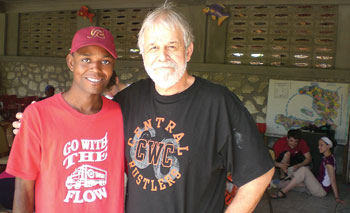Tilton teaches outdoor medicine in Haiti
January 1, 2011

Central Wyoming College English instructor Buck Tilton put his skills in wilderness medicine to work caring for impoverished and sick people in a remote village in Haiti this past summer.
Tilton, the founder of the Wilderness Medicine Institute, which is now operated by the National Outdoor Leadership School, taught eager Haitians how to assess illness as well as the basics of splinting and bandaging.
Tilton joined a group of first year medical school students on a mission in May to Verrettes, a remote village high in the Haitian mountains about a four-hour drive from the capital of Port-au-Prince. Verrettes was not affected by the 2010 earthquake, though the village has been ravaged by cholera and other water-borne illnesses, HIV and poverty and very limited access to health care.
Dr. William Forgey, an instructor at Indiana University’s School of Medicine, asked his old friend Buck, who has published 43 books and thousands of articles on wilderness medicine, to join the mission. Shortly after CWC’s spring commencement, Tilton met with the students in Miami for the trip to the Caribbean island that Haiti shares with the Dominican Republic.
Dr. Forgey founded a program called Medical Student Missions to promote volunteer medical service, and asked Tilton to train students in wilderness medicine as well as the locals.
Utilizing the services of a local translator, Tilton demonstrated first aid lessons with his interpreter translating the instruction into Haitian Creole. He focused on assessments of the patients, teaching his students how to ask the right questions to determine ailments and conditions patients might be experiencing.
His Haitian students have a history of volunteering and that is how they were selected to receive his instruction. These villagers would walk up the mountain for hours to carry an old woman on a door down to the clinic, Tilton recalled. The medical mission left the volunteers with a litter for their subsequent missions to aid the sick and injured.
Tilton also helped out at the village’s clinic. “Every day a hundred, or two or three hundred, line up and wait with torpid patience to be examined and given a packet of Advil or an anti-diarrheal or a vitamin,” he said. “The ones who test positive for HIV are told, sorry, there’s nothing we can do, but we recommend you visit the Albert Schweitzer Hospital at the other end of the valley…where it is most likely you will be told there’s nothing we can do. I don’t say that last part out loud, but I know it’s true,” Tilton wrote of his summer visit.
Verrettes is the epicenter of the cholera epidemic though many of the patients had a variety of illnesses that could be treated by Tilton’s brand of outdoor medicine. “That’s the kind of medicine they have,” he said. “It’s quite a ways to a hospital.”
There is no running water in the village so the children, who called Tilton “Blanc” because of his white skin, bring plastic jugs to a spring that offers the only source of cholera-free water in the area.
Hunger and the illnesses that follow on extreme poverty are prevalent, which gave Buck a feeling of total hopelessness for his short-term Haitian home.
The mountain people of Verrettes are relatively fortunate over their neighbors in Port-au-Prince where more than a million people are still living in tents or under tattered tarps. “At least those one million people are alive,” Tilton wrote, “not the nearly quarter million that died within hours of the start of the earthquake of January 2010.”
His mountain community that once had a carpet of green and flowering trees is now barren and rocky. “Trees make coals, coals cook goat, and 9.75 million people, the current population of Haiti, gotta eat,” he wrote.
The earthquake and its aftermath is what brought Tilton to Haiti in the first place. The country is slightly smaller than Maryland with double the number of residents . . .”a nation with all its arable land planted yet unable to produce enough food to feed half its 9.75 million inhabitants. The nation feeds the other half with imported food given to them by fatter nations.”
“There is no food…no jobs, and they can’t afford to leave the country because they don’t have any money,” he added.
"Yes, Haiti is a thin nation. The people are thin, the goats are thin, the few trees are thin, the soil is thin – and hope is thin. I have handed out a few tablets of amoxicillin, spoken encouragement through an interpreter, spoken doom to others, eaten their goat and their papaya – I will go home, I decide, taking more than I leave behind. I smile and wave to the smiling children, calling out “Oui, blanc. Mersi, mersi.”